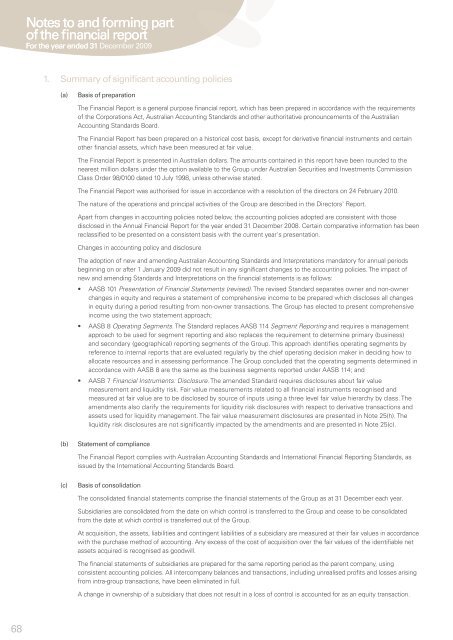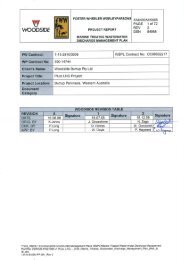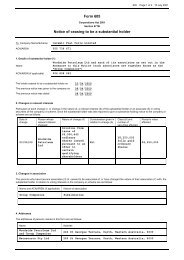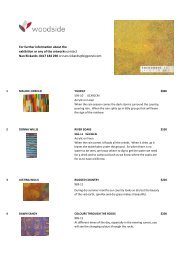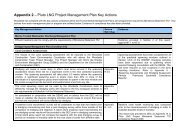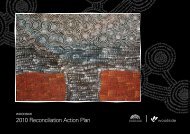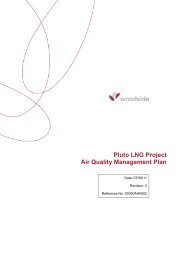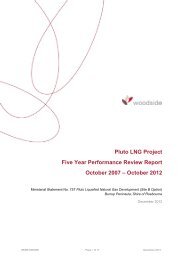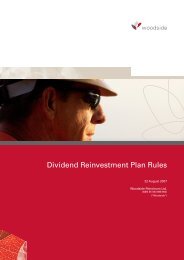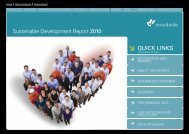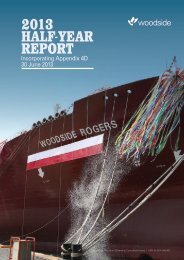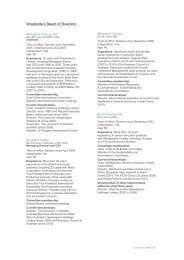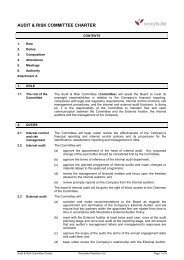24.02.2010 annual report 2009.pdf - Woodside
24.02.2010 annual report 2009.pdf - Woodside
24.02.2010 annual report 2009.pdf - Woodside
You also want an ePaper? Increase the reach of your titles
YUMPU automatically turns print PDFs into web optimized ePapers that Google loves.
68<br />
Notes to and forming part<br />
of the financial <strong>report</strong><br />
For the year ended 31 December 2009<br />
1. Summary of significant accounting policies<br />
(a) Basis of preparation<br />
The Financial Report is a general purpose financial <strong>report</strong>, which has been prepared in accordance with the requirements<br />
of the Corporations Act, Australian Accounting Standards and other authoritative pronouncements of the Australian<br />
Accounting Standards Board.<br />
The Financial Report has been prepared on a historical cost basis, except for derivative financial instruments and certain<br />
other financial assets, which have been measured at fair value.<br />
The Financial Report is presented in Australian dollars. The amounts contained in this <strong>report</strong> have been rounded to the<br />
nearest million dollars under the option available to the Group under Australian Securities and Investments Commission<br />
Class Order 98/0100 dated 10 July 1998, unless otherwise stated.<br />
The Financial Report was authorised for issue in accordance with a resolution of the directors on 24 February 2010.<br />
The nature of the operations and principal activities of the Group are described in the Directors' Report.<br />
Apart from changes in accounting policies noted below, the accounting policies adopted are consistent with those<br />
disclosed in the Annual Financial Report for the year ended 31 December 2008. Certain comparative information has been<br />
reclassified to be presented on a consistent basis with the current year's presentation.<br />
Changes in accounting policy and disclosure<br />
The adoption of new and amending Australian Accounting Standards and Interpretations mandatory for <strong>annual</strong> periods<br />
beginning on or after 1 January 2009 did not result in any significant changes to the accounting policies. The impact of<br />
new and amending Standards and Interpretations on the financial statements is as follows:<br />
• AASB 101 Presentation of Financial Statements (revised). The revised Standard separates owner and non-owner<br />
changes in equity and requires a statement of comprehensive income to be prepared which discloses all changes<br />
in equity during a period resulting from non-owner transactions. The Group has elected to present comprehensive<br />
income using the two statement approach;<br />
• AASB 8 Operating Segments. The Standard replaces AASB 114 Segment Reporting and requires a management<br />
approach to be used for segment <strong>report</strong>ing and also replaces the requirement to determine primary (business)<br />
and secondary (geographical) <strong>report</strong>ing segments of the Group. This approach identifies operating segments by<br />
reference to internal <strong>report</strong>s that are evaluated regularly by the chief operating decision maker in deciding how to<br />
allocate resources and in assessing performance. The Group concluded that the operating segments determined in<br />
accordance with AASB 8 are the same as the business segments <strong>report</strong>ed under AASB 114; and<br />
• AASB 7 Financial Instruments: Disclosure. The amended Standard requires disclosures about fair value<br />
measurement and liquidity risk. Fair value measurements related to all financial instruments recognised and<br />
measured at fair value are to be disclosed by source of inputs using a three level fair value hierarchy by class. The<br />
amendments also clarify the requirements for liquidity risk disclosures with respect to derivative transactions and<br />
assets used for liquidity management. The fair value measurement disclosures are presented in Note 25(h). The<br />
liquidity risk disclosures are not significantly impacted by the amendments and are presented in Note 25(c).<br />
(b) Statement of compliance<br />
The Financial Report complies with Australian Accounting Standards and International Financial Reporting Standards, as<br />
issued by the International Accounting Standards Board.<br />
(c) Basis of consolidation<br />
The consolidated financial statements comprise the financial statements of the Group as at 31 December each year.<br />
Subsidiaries are consolidated from the date on which control is transferred to the Group and cease to be consolidated<br />
from the date at which control is transferred out of the Group.<br />
At acquisition, the assets, liabilities and contingent liabilities of a subsidiary are measured at their fair values in accordance<br />
with the purchase method of accounting. Any excess of the cost of acquisition over the fair values of the identifiable net<br />
assets acquired is recognised as goodwill.<br />
The financial statements of subsidiaries are prepared for the same <strong>report</strong>ing period as the parent company, using<br />
consistent accounting policies. All intercompany balances and transactions, including unrealised profits and losses arising<br />
from intra-group transactions, have been eliminated in full.<br />
A change in ownership of a subsidiary that does not result in a loss of control is accounted for as an equity transaction.


